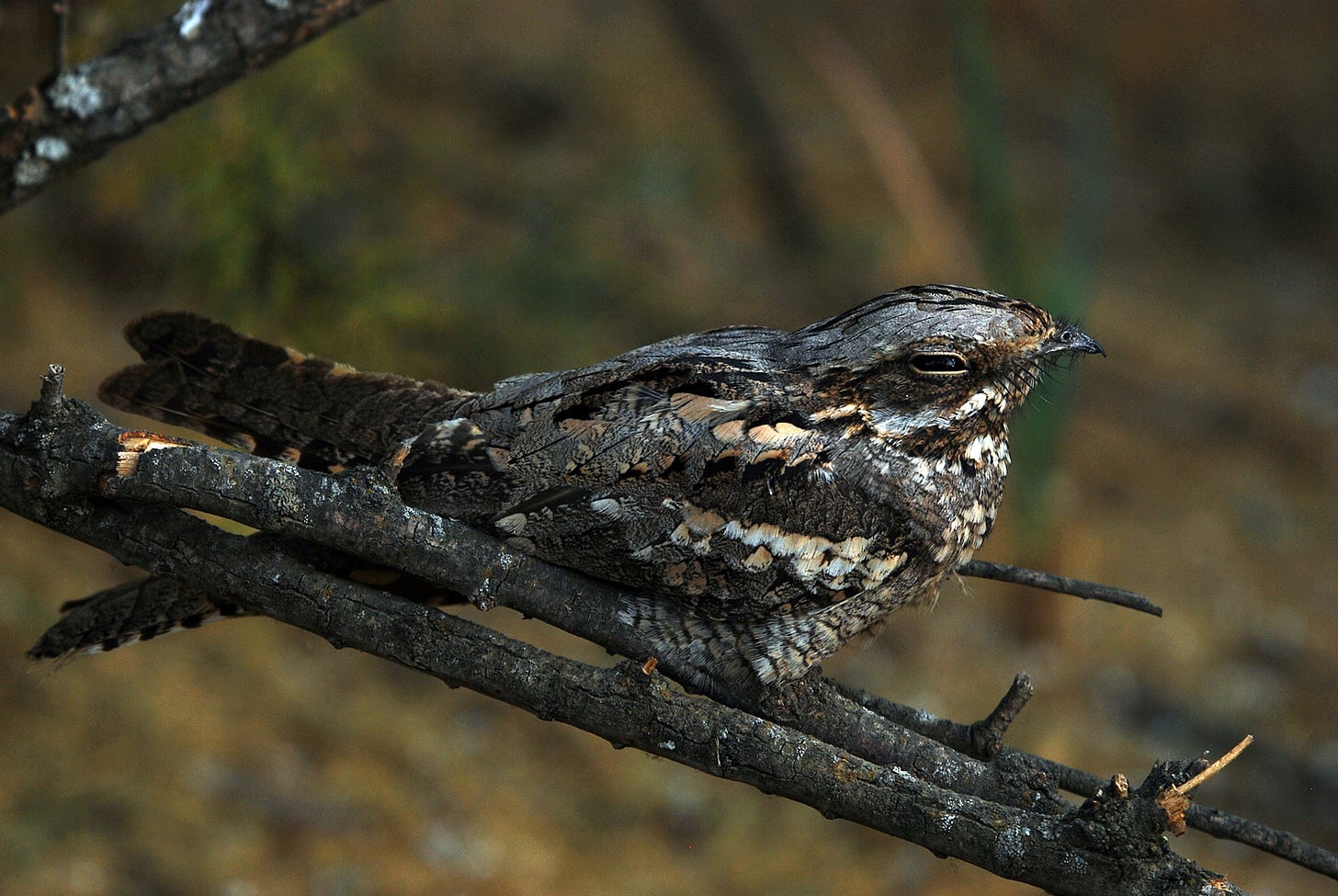The churring of a nightjar seems more electricity substation than birdsong, and its weirdness is amplified by its timing.
Male nightjars sing in the summer months, once the sun’s down. The sound is two-tone, switching in pitch and intensity, as if adjusted by dials. Think: recently arrived aliens surveilling the landscape with excellent sonic tech.
The persistent churring is often accompanied by a couple of sharper noises. One is a wet-sounding kew-ick, given when they are on the wing. The other the sound of the wings actually being clapped together (you can hear the claps at the very end of the recording above).
With these audible clues, and enough light remaining in the sky, you may catch the silhouette of their slow-winged flight as they patrol the air.
Nightjars need open areas, with low ground cover in which to nest, and plenty of moths and other flying insects to feed on at night. They have a startlingly wide gape, and pronounced, whisker-like bristles around their face to help them locate their prey by feel.
Nightjars are occasionally to be found at rest during the day, when their cryptic plumage allows them blend in with a log, or simply remain undetectable amidst dry bracken and heather.
However, they have a long season of churring, until at least the end of July, in which we can catch their twilight manoeuvres.
The experience of being with nightjars has a special place in many people’s calendars, involving a seasonal visit to heathland, usually with a friend or two for reassurance in the dark.
The act of watching them has a notable place in the history of ornithology too, as told by Tim Birkhead in The Wisdom of Birds.
[Andrew] Selous’s first scientific paper was published in The Zoologist in 1899, and described his observations of a pair of nesting nightjars observed at close range from behind an elder bush. This was extraordinary; no-one (other than hunters), it seems, had watched wild birds like this before, and the results spoke for themselves. The editor of The Zoologist singled out Selous’ unique study for praise and The Saturday Review declared that Selous had exceeded Gilbert White’s observations on the nightjar, referring to him as a ‘born field naturalist’.
There was more to Selous than just watching birds. He had a mission, and saw himself as a pioneer. He wanted to change ornithology, to do away with shooting, collecting and classifying birds, summing up his vision thus: ‘The zoologist of the future should be a different kind of man altogether: the present one is not worthy of the name. He should go out with glasses [binoculars] and notebook, prepared to see and think.’ The idea of giving up the gun in favour of binoculars was ground-breaking indeed. Little wonder the professionals hated him.
Here’s to going out, and being prepared to see, and listen, and think.
Goes well with: Cosmo Sheldrake
Thank you for reading and listening to Shriek of the Week. Your ideas, comments and recommendations make this a lot of fun. If you subscribe with an annual or monthly subscription you also get every species narrated (a 3-4 minute audio version), and full access to the archive of over 55 species and counting. Plus an invitation to join our monthly bird-listening club, on the first Saturday of the month. In July we’ll be tuning into wilding.radio together and identifying what we can hear. It’s a good way to start the weekend.
Enjoy the birds
~ Charlie
Last thought: If you don’t hear it, does it count?
“For the longest era, birding was entirely about the act of spotting — with one’s eyes — the bird being sought. The consensus was: if you only hear it, but don’t see it, it doesn’t count, right? But horizons shift. With a birdsong renaissance in full effect, our Charlie describes the liberating feeling of that change in the air, now that he’s started to hear people say: if you only see it, but don’t hear the song, it doesn’t count, right?”
Read The library and the birdsong walk on Chris Thorpe-Tracey’s The Border Crossing.
Media credits:
Song recorded at Cannock Chase, Staffordshire on 4th July 1975 by Richard Margoschis, and made available by The British Library.
Image by Dûrzan cîrano via Wikipedia reproduced under Creative Commons licence CC BY-SA 3.0




